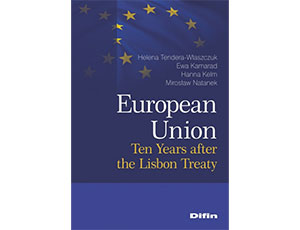
10 years have passed since the entry into force of the Lisbon Treaty. Referring to this anniversary, four researchers form Cracow University of Economics, Jagiellonian University and University of Economics in Katowice have undertaken an attempt to summarize the most important changes that took place in the last decade in the European Union.
The Lisbon Treaty, which entered into force on December 9, 2009, was the longest negotiated and the most controversial treaty in the history of the European integration. It was also one of the treaties, next to the Single European Act and the Maastricht Treaty, which introduced the greatest changes in the principles and mechanisms of the functioning of the European Union. This treaty was seen as a possibility of implementation of the greatest and most successful project in economic and political integration in the world. It realized the vision of a stronger, more democratic and ever closer union. 10 years have passed since the entry into force of the Lisbon Treaty. Referring to this anniversary, four researchers form Cracow University of Economics, Jagiellonian University and University of Economics in Katowice have undertaken an attempt to summarize the most important changes that took place in the last decade in the European Union. The authors focused on the following problems: Selected reforms of the EU institutional system with particular regard to the European Council, The role of the Lisbon Treaty in facing the crisis in the Euro Zone, The impact of the implemented welfare state concept on leveling the socio-economic distance of the European Union new Member States to the EU-15, The withdrawal of a Member State from the European Union in the light of Article 50 TEU on the example of the United Kingdom.
Table of contents:
Introduction
Chapter 1. An Attempt to Assess the Selected Reforms of the EU Institutional System with Particular Regard to the European Council
Introduction
1.1. Institutional reforms – the example of the European Council
1.2. Conclusions
Literature
Chapter 2. The role of the Lisbon Treaty in Facing the Crisis in the Euro Zone
Introduction
2.1. The theoretical backgrounds of the euro zone
2.2. The financial crisis and its tension in the European economies
2.2.1. The state of public finances – deficit and level of debt – in the GIPSY countries
2.3. The Stability and Growth Pact (SGP)
2.4. Facing a crisis in the Lisbon Treaty
2.5. Conclusions
Literature
Chapter 3. The impact of the implemented welfare state concept on leveling the socio-economic distance of the European Union new Member States to the EU-15
Introduction
3.1. The implementation of different welfare state models in the EU Member States: a theoretical approach
3.2. Analysis and assessment of the effectiveness of leveling the socio-economic distance of NMS to EU-15 Member States
3.3. Conclusions
Literature
Chapter 4. The withdrawal of a Member State from the European Union in the light of Article 50 TEU on the example of the United Kingdom
Introduction
4.1. Possibility of a Member State's withdrawal from the European Union
4.1.1. Before the adoption of the Lisbon Treaty
4.1.2. After the adoption of the Lisbon Treaty
4.2. The procedure for the withdrawal of a Member State from the European Union
4.2.1. Undertaking a decision on the withdrawal
4.2.2.The notification of the intention to withdraw submitted to the European Council
4.2.3. Negotiations of a country withdrawing from with the EU
4.2.4. The agreement of withdrawal from the EU
4.3. A lack of Withdrawal Agreement
4.4. The effects of a Member State's withdrawal from the EU
4.5. The withdrawal of the United Kingdom from the European Union
4.5.1. Arguments for and against the withdrawal
4.5.2. Referendum on the Brexit
4.5.3. Decision to withdraw from the EU
4.5.4. Possible forms of cooperation between the United Kingdom and the European Union after the Brexit
4.6. Negotiations on the withdrawal
4.7. Conclusions
Literature

